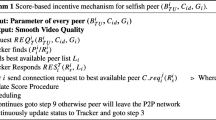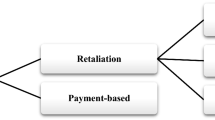Abstract
Free-riding is one of the main challenges of Peer-to-Peer (P2P) streaming systems which results in reduction in video streaming quality. Therefore, providing an incentive mechanism for stimulating cooperation is one of the essential requirements to maintain video Quality of Experience (QoE) in such systems. Among the existing mechanisms, payment-based schemes are most suitable for streaming applications due to their low overhead. However, to date, no dynamic payment mechanism has been proposed which can take the stochastic dynamics of the video streaming ecosystem (e.g., the request arrival, demand submission, bandwidth availability, etc.) into account. In this paper, we propose a dynamic token-based payment mechanism in which each peer earns tokens by admitting other peers’ requests and spends tokens for submitting its demands to the others. This system allows the peers to dynamically adjust their income level in adaptation to changes in the system state. We propose a Constrained Markov Decision Process (CMDP) formulation in which the goal of each peer is to obtain a request admission policy which minimizes the expected cumulative cost of consumed bandwidth, while satisfying a long-term constraint on the Mean Opinion Score (MOS) of the users as the measure of QoE. The proposed admission policy is adaptive to the request arrival process, bandwidth state and the token bucket length of each peer. To make up for the lack of design-time knowledge of the system’s statistics, each individual peer is equipped with a model-free algorithm to learn its optimal admission policy over the course of real-time interaction with the system. Simulation results are presented to compare the performance of the proposed algorithm against baseline schemes such as: random, token-threshold, bandwidth-threshold and myopic algorithms.













Similar content being viewed by others
Notes
VCR (Video Cassette Recorder) functions include play forward, play backward, fast forward, fast backward, slow forward, slow backward, jump forward, jump backward, pause, and so on.
References
Altman E (1999) Constrained Markov Decision Processes. Hall/CRC, Chapman &
Bertsekas D (1999) Nonlinear programming. Athena Scientific, Belmont
Bertsekas D, Shreve SE (1978) Stochastic optimal control: the discrete time case. Academic Press, New York
Bertsekas DP, Tsitsiklis JN (1995) Neuro-dynamic programming: an overview. Decision and Control, Proceedings of the 34th IEEE Conference on 1:560–564
Borkar VS (1997) Stochastic approximation with two time scales. Systems & Control Letters 29(5):291–294
Borkar VS (2005) An actor-critic algorithm for constrained Markov decision processes. Systems & control letters 54(3):207–213
Borkar VS (2008) Stochastic Approximation: A Dynamical Systems Viewpoint. Press, Cambridge University
Buttyan L and Hubaux J-P (2001) “Nuglets: a Virtual Currency to Stimulate Cooperation in Self-Organized Mobile Ad Hoc Networks,” EPFL Technical Report
Castro M, Druschel P, Kermarrec AM, Nandi A, Rowstron A, and Singh A (2003) “SplitStream: high-bandwidth multicast in cooperative environments,” in Proceedings of the 9th ACM Symposium on Operating Systems Principles, Bolton Landing, NY pp. 292-303
Ciuoletti A (2010) Secure token passing at application level. Futur Gener Comput Syst 26:1026–1031
Djonin DV, Krishnamurthy V (2007) Q-learning algorithms for constrained markov decision processes with randomized monotone policies: application to MIMO transmission control. IEEE Trans Signal Process 55(5):2170–2181
Dolgov DA and Durfee EH (2003) “Approximating optimal policies for agents with limited execution resources,” in IJCAI, pp. 1107–1112
Fan J, Liang RZ (2016) "Stochastic learning of multi-instance dictionary for earth mover's distance-based histogram comparison", Neural Computing and Applications, 1–11
Franklin M, Reiter M (1997) “Fair exchange with a semi-trusted third party,” ACM conference on Computer and Communication Security, Zurich, Switzerland, pp. 1-5
Gehret BA, Sutton RS, Watkins CJCH (1990) Learning and sequential decision making. In: Gabriel M, Moore JW (eds) Learning and computational neuroscience: foundations of adaptive networks. MIT Press, Cambridge
Habib A, Chuang J (2006) Service differentiated peer selection: an incentive mechanism for peer-to-peer media streaming. IEEE Transactions on Multimedia 8(3):610–621
Hernando D, de Vergara JE, Madrigal D, Mata F (2013) Evaluating quality of experience in IPTV services using MPEG frame loss rate. Smart Communications in Network Technologies (SaCoNeT), International Conference on 3:1–5
ITU-T Rec. P.800.2 (2013) Mean Opinion Score (MOS) interpretation and reporting
Kang X and Wu Y (2015) “Incentive Mechanism Design for Heterogeneous Peer-to-Peer Networks: A Stackelberg Game Approach,” IEEE Transactions on Mobile Computing, vol. 14, no. 5
Karakaya M, Korpeoglu I, Ulusoy O (2009) Free riding in peer-to-peer networks. IEEE Internet Comput 13(2):92–98
Landa R, Rio M, Griffin D, Clegg R, and Mykoniati E (2008) “Incentives against hidden action in QoS overlays,” in Peer-to-Peer Computing, pp. 12–21
Li B, Yin H (2007) Peer-to-peer live video streaming on the internet: issues, existing approaches, and challenges. IEEE Commun Mag 45(6):94–99
Liang RZ, Shi L, Wang H, Meng J, Wang JJY, Sun Q, Gu Y (2016) "Optimizing Top Precision Performance Measure of Content-Based Image Retrieval by Learning Similarity Function", Pattern Recognition (ICPR), 23st International Conference on
Liao WC, Papadopoulos F, Psounis K (2006) An efficient algorithm for resource sharing in peer-to-peer networks, In International Conference on Research in Networking, Springer Berlin Heidelberg, pp. 592–605
Lin WS, Zhao HV, and Liu KR (2008) “A game theoretic framework for incentive-based peer-to-peer live-streaming social networks,” in IEEE International Conference on Acoustics, Speech and Signal Processing,Las Vegas, NV, pp. 2141–2144
Lin WS, Zhao HV, Liu KR (2009) Incentive cooperation strategies for peer-to-peer live multimedia streaming social networks. IEEE Transactions on Multimedia 11(3):396–412
Liu Y, Guo Y, Liang C (2008) A survey on peer-to-peer video streaming systems. SPRINGER The Journal of Peer-to-Peer Networking and Applications 1(1):18–28
Maani E, Chen Z, and Katsaggelos AK (2012) “A game theoretic approach to video streaming over peer-to-peer networks,” Signal Processing: Image Communication 27(5):545-554
Macone D, Oddi G, Pietrabissa A (2013) MQ-routing: mobility-, GPS- and energy-aware routing protocol in MANETs for disaster relief scenarios. Ad Hoc Netw 11(3):861–878
Magharei N, Rejaie R (2009) Prime: peer-to-peer receiver-driven mesh-based streaming. IEEE/ACM Transactins on Networking (TON) 17(4):1052–1065
Mastronarde N, Pate V, Xu J, Liu L, van der Schaar M (2016) To relay or not to relay: learning device-to-device relaying strategies in cellular networks. IEEE Trans Mob Comput 15(6):1569–1585
Meddour D, Mushtaq M and Ahmed T (2006) “Open issues in p2p multimedia streaming,” in Proceedings of the workshop of the IEEE international Conference on Communications (MULTICOMM '06), Istanbul
Mitchell TM (1997) Machine Learning. McGraw-Hill, Science/Engineering/Math
Montazeri A and Akbari B (2011) “Providing incentives for video streaming in mesh based P2P networks,” in Computer Networks and Distributed Systems (CNDS), pp. 181–186
Montazeri A, Akbari B, Ghanbari M (2012) An incentive scheduling mechanism for peer-to-peer video streaming. Peer-to-Peer Networking and Applications 5(3):257–278
Mostafavi S and Dehghan M (2015) “Game-Theoretic Bandwidth Procurement Mechanisms in Live P2P Streaming System,” Multimedia Tools and Applications 75(14):8545–8568
Mostafavi S and Dehghan M (2015) “Game-Theoretic Auction Design for Bandwidth Sharing in Helper-Assisted P2P Streaming,” International Journal of Communication Systems, 1–16
Nisan N, Roughgarden T, Tardos É, Vazirani VV (2007) Algorithmic game theory. Cambridge Univ. Press, Cambridge
Padmanabhan VN, Wang HJ, and Chou PA (2003) “Resilient peer-to-peer streaming,” in Proceedings of the 11th IEEE Intenational Conference on Network Protocols (ICNP '03), Atlanta
Pai V and Mohr AE (2006) “Improving robustness of peer-to-peer streaming with incentives,” The 1st Workshop on the Economics of Networks, Systems and Computation 1st NetEcon
Pai V, Kumar K, Tamilmani K, Sambamurthy V, and Mohr A (2005) “Chainsaw: Eliminating trees from overlay multicast,” in Proceedings of the IEEE International Workshop on Peer-to-Peer Systems, Ithaca
Qiao L, Nahrstedt K (1998) Comparison of MPEG encryption algorithms. Comput Graph 22(4):437–448
RFC 3640, IETF, p. 31. https://tools.ietf.org/html/rfc3640#page-31
RFC 7266 - RTP Control Protocol (RTCP) Extended Report (XR) Blocks for Mean Opinion Score (MOS) Metric Reporting.htm
Salodkar N, Bhorkar A, Karandikar A, Borkar VS (2008) An on-line learning algorithm for energy efficient delay constrained scheduling over a fading channel. IEEE Journal on Selected Areas in Communications 26(4):732–742
Schollmeier R (2001) A definition of peer-to-peer networking for the classification of peer-to-peer architectures and applications. In Proceedings of the IEEE First International Conference on Peer-to-Peer Computing, Linkoping, Sweden
Shuang Y, and Xin W (2008) “A probabilistic approach to analyze the effect of free-riders in P2P streaming services,” in Proceedings of IFIP International Conference on Network and Parallel Computing (NPC '08), Shanghai
Singh S, Jaakkola T, Littman ML, Szepesvári C (2000) Convergence results for single-step on-policy reinforcement-learning algorithms. Mach Learn 38(3):287–308
Sutton RS and Barto AG (1998) Reinforcement learning: An introduction, vol. 1, Cambridge Univ Press
Tan G, Jarvis SA (2008) A payment-based incentive and service differentiation scheme for peer-to-peer streaming broadcast. IEEE Transactions on Parallel and Distributed Systems 19(7):940–953
Tharakunnel K (2008) Leader-follower multiagent systems: incentive design with limited information. University of Illinois, Chicago
Vishnumurthy SCV and Sirer EG (2003) “KARMA: A Secure Economic Framework for P2P Resource Sharing,” Proc. ACM SIGCOMM Workshop Economics of Peer-To-Peer Systems (P2PECON)
Vishnumurthy V, Chandrakumar S and Sirer EG (2003) “KARMA: A Secure Economic Framework for Peer-to-Peer Resource Sharing”, Workshop on the Economics of Peer-to-Peer Systems
Vrancx P (2011) Decentralized reinforcement learning in Markov games, ASP/VUBPRESS/UPA
Watkins CJCH, Dayan P (1992) Q-learning. Mach Learn 8(3):279–292
Xinyan Z, Jiangchuan L, Bo L, and Yum YSP (2005) “CoolStreaming/DONet: a data-driven overlay network for peer-to-peer live media streaming,” in Proceedings of the 24th Annual joint Conference of the IEEE computer and Communications Societies (INFOCOM '05), Miami
Xu J, Van Der Schaar M (2013) Token system design for autonomic wireless relay networks. IEEE Trans Commun 61(7):2924–2935
Xu J, van der Schaar M and Zame W (2011) "Designing practical distributed exchange for online communities," arXiv preprint arXiv:1108.5871
Zhang Y and van der Schaar M (2011) Designing incentives for P2P multimedia sharing, in IEEE Global Telecommunications Conference (GLOBECOM), Kathmandu, Nepal pp. 1–6
Author information
Authors and Affiliations
Corresponding author
Rights and permissions
About this article
Cite this article
Aslani, R., Hakami, V. & Dehghan, M. A token-based incentive mechanism for video streaming applications in peer-to-peer networks. Multimed Tools Appl 77, 14625–14653 (2018). https://doi.org/10.1007/s11042-017-5051-9
Received:
Revised:
Accepted:
Published:
Issue Date:
DOI: https://doi.org/10.1007/s11042-017-5051-9




